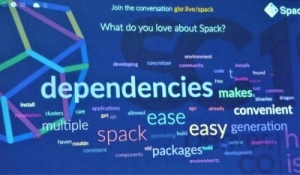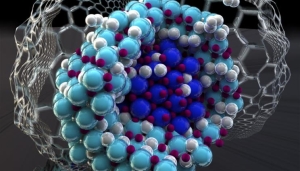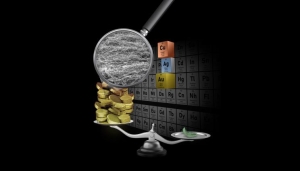LAB REPORT
Science and Technology Making Headlines
Dec. 13, 2019


Lawrence Livermore has been honored for the second year in a row with a Glassdoor Employees’ Choice Award, recognizing the Laboratory as one of the top 10 best places to work nationwide in 2020.
Lab is top dog to employees
Lawrence Livermore has been honored for the second year in a row with a Glassdoor Employees’ Choice Award, recognizing the Laboratory as one of the top 10 best places to work nationwide in 2020.
The Employees’ Choice Awards program, now in its 12th year, is based solely on the input of employees who elect to provide feedback on their jobs, work environments and companies on Glassdoor, one of the world’s largest job and recruiting sites.
LLNL, already a 2019 winner, jumped 18 spots for 2020, ranking 6 out of 100 on Glassdoor’s “Best Places to Work U.S Large.” LLNL received an overall company rating of 4.5 and is ranked the No. 1 government/government contractor employer and the No. 1 laboratory employer. LLNL also is No. 2 on the list of large employers in the Bay Area.
On Glassdoor, current and former employees voluntarily and anonymously share insights and opinions about their work environments by sharing a company review, designed to capture a genuine and authentic inside look at what a specific job may be like at a particular company. When sharing a company review on Glassdoor, employees are asked to rate their satisfaction with the company overall, and key workplace factors like career opportunities, compensation and benefits, culture and values, senior management and work/life balance. In addition, employees are asked to describe the best reasons to work at their companies as well as any downsides.


This artist’s concept depicts the NASA OSIRIS-REx spacecraft contacting the asteroid Bennu. The mission aims to return a sample of Bennu's surface coating to Earth for study as well as return detailed information about the asteroid and its trajectory. Image courtesy of NASA's Goddard Space Flight Center.
Asteroid is on active duty
NASA's OSIRIS REx mission has now found that asteroid Bennu is very much active with observable events happening on its surface. Recently, NASA scientists detected particle plumes ejecting off the surface of Bennu, and it strongly suggests that the space body is in an active state.
Asteroid Bennu is basically a rubble-pile asteroid, where a group of rocks is held together by gravity rather than a single object. Particles emitting from an asteroid's surface are very rare, and it is the first time that scientists had a close-up observation of this phenomenon.
There’s been some concern that Bennu in the very far future could be on a collision course with Earth.
Kirsten Howley, a physicist at Lawrence Livermore National Laboratory and a member of the U.S. planetary defense team, said that learning the trajectory of this space body is very much necessary to combat a possible catastrophe.
"The probability of a Bennu impact maybe 1 in 2,700 today, but that will almost certainly change, for better or worse — as we gather more data about its orbit. Delay is the greatest enemy of any asteroid deflection mission. That's why there's urgency in getting viable deflection platforms on the shelf today," Howley said.


Spack users were asked what they like about the software package.
On the spack track
At the annual supercomputing conference, SC19 in Denver, Colorado, there were Spack events each day of the conference.
Spack is an open-source scientific software package manager for high-performance computing (HPC) environments, MacOS and Linux platforms. It simplifies an otherwise tedious and time-consuming task.
At LLNL, Spack was used to automate the radiation hydrodynamics code, ARES, with 40 dependency libraries on a dozen compilers running on Blue Gene/Q and commodity Linux clusters. Porting time on a new platform was reduced from two weeks to three hours.
Todd Gamblin, senior principal member of technical staff, leads the LLNL Spack development effort. The development team is in the process of democratizing a pipeline of software management across six DOE labs; automated package builds with both public and private repositories that will work with dozens of systems.

Hydrogenation forms a mixture of lithium amide and hydride (light blue) as an outer shell around a lithium nitride particle (dark blue) nanoconfined in carbon. Nanoconfinement suppresses all other intermediate phases to prevent interface formation, which has the effect of dramatically improving the hydrogen storage performance.
Nano goes efficient
Lawrence Livermore scientists have collaborated with an interdisciplinary team of researchers to develop an efficient hydrogen storage system that could be a boon for hydrogen-powered vehicles.
Hydrogen is an excellent energy carrier, but the development of lightweight solid-state materials for compact, low-pressure storage is a huge challenge.
Complex metal hydrides are a promising class of materials, but their viability is usually limited by slow hydrogen uptake and release. Nanoconfinement — infiltrating the metal hydride within a matrix of another material such as carbon — can, in certain instances, help make this process faster by shortening diffusion pathways for hydrogen or by changing the thermodynamic stability of the material.
The researchers examined the high-capacity lithium nitride (Li3N) hydrogen storage system under nanoconfinement. Using a combination of theoretical and experimental techniques, they showed that the pathways for the uptake and release of hydrogen were fundamentally changed by the presence of nano-interfaces, leading to dramatically faster performance and reversibility.
“The key is to get rid of the undesirable intermediate phases, which slow down the material's performance as they are formed or consumed. If you can do that, then the storage capacity kinetics dramatically improve and the thermodynamic requirements to achieve full recharge become far more reasonable,” said Brandon Wood, an LLNL materials scientist. “In this material, the nano-interfaces do just that, as long as the nanoconfined particles are small enough. It‘s really a new paradigm for hydrogen storage, since it means that the reactions can be changed by engineering internal microstructures.”

Ultra-lightweight gold, copper and silver foams are lighter than a parakeet feather. Illustration by Amy Henke/LLNL
New form of foam strikes gold
Lawrence Livermore National Laboratory scientists have created the lightest gold foam to date.
The new form of ultralight gold aerogel foam has applications in electronics, catalysis, sensors and energy conversion and storage.
Aerogels are a type of material that are lightweight, have a high surface area and are made up of a nanoporous network with densities between 1 and 1,000 milligrams per cubic centimeter. A wide range of metals and metal alloys have been made into ultralight, monolithic foams, including nickel, cobalt, copper and silver.
However, the synthesis of ultralight gold aerogel foams has remained elusive. Ultralow-density gold foams with microscopically uniform pores are uniquely suited as targets for ultrabright X-ray sources and studying high-energy-density physics at high-power laser facilities. This is a very impactful work, as it demonstrates the lightest gold foam in the world, and will be used for targets for the National Ignition Facility (the largest and most energetic laser in the world).





